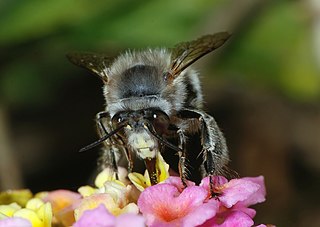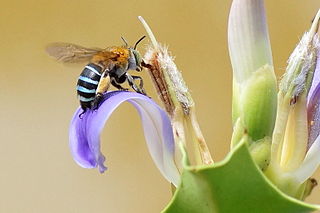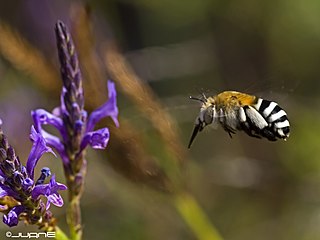
The Anthophorini are a large tribe in the subfamily Apinae of the family Apidae. Species in this tribe are often referred to as digger bees, although this common name is sometimes also applied to members of the tribe Centridini. It contains over 750 species worldwide, all of which were previously classified in the obsolete family Anthophoridae along with members of several other tribes; the vast majority of species in the tribe Anthophorini are in the genera Amegilla and Anthophora.

The bee genus Anthophora is one of the largest in the family Apidae, with over 450 species worldwide in 14 different subgenera. They are most abundant and diverse in the Holarctic and African biogeographic regions. All species are solitary, though many nest in large aggregations. Nearly all species make nests in the soil, either in banks or in flat ground; the larvae develop in cells with waterproof linings and do not spin cocoons. Males commonly have pale white or yellow facial markings, and/or peculiarly modified leg armature and hairs. Anthophora individuals can be distinguished from the very similar genus Amegilla by the possession of an arolium between the tarsal claws.

Amegilla is a large genus of bees in the tribe Anthophorini. Several species have blue metallic bands on the abdomen, and are referred to as "blue-banded bees". The genus occurs all around the world but very few live above 45° North.

Amegilla cingulata is a species of blue-banded bees that is native to Australia and occurs in many other regions. Currently, several scientific organizations are conducting research on how A. cingulata benefits agriculture through its distinctive "buzz pollination". These bees are very important for the production of food and contribute to at least 30% of crops in Australia.

Amegilla bombiformis, commonly known as the teddy bear bee or golden haired mortar bee, is an Australian native bee in the family Apidae.

Amegilla quadrifasciata, the white-banded digger bee, is a species of bee belonging to the family Apidae subfamily Apinae.
Amegilla confusa, is a species of bee belonging to the family Apidae subfamily Apinae.
Amegilla violacea is a species of bee belonging to the family Apidae subfamily Apinae.
Amegilla mucorea, is a species of bee belonging to the family Apidae subfamily Apinae.
Amegilla fallax is a species of bee belonging to the family Apidae subfamily Apinae.
Amegilla subcoerulea is a species of bee belonging to the family Apidae subfamily Apinae.
Amegilla cingulifera, is a species of bee belonging to the family Apidae subfamily Apinae.
Amegilla comberi, is a species of bee belonging to the family Apidae subfamily Apinae.
Amegilla niveocincta, is a species of bee belonging to the family Apidae subfamily Apinae.
Amegilla perasserta, is a species of bee belonging to the family Apidae subfamily Apinae.
Amegilla subinsularis, is a species of bee belonging to the family Apidae subfamily Apinae.
Amegilla zonata is a species of blue-banded bees belonging to the family Apidae, widely distributed in SE Asia, where it is often confused with the Australian species Amegilla cingulata.

Amegilla canifrons, the Canary islands Blue-banded bee is a species of bee, belonging to the family Apidae. The species is endemic to Canary Islands.
Josephine Christina Cardale worked as an entomologist for CSIRO from 1967 to 2001. She was a collection manager of Hymenoptera at the Australian National Insect Collection.






